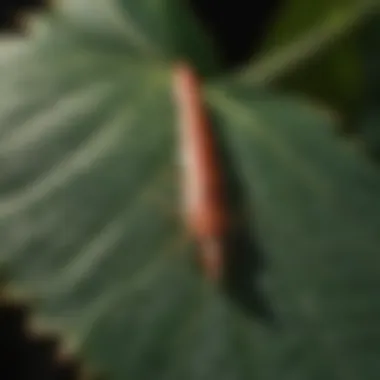Understanding Arrow Pest Management in Panama City


Intro
Managing pests effectively is essential for maintaining healthy homes and gardens, especially in a region like Panama City, where the climate can encourage a variety of pests. Understanding these pests, particularly arrow pests, is crucial for homeowners and gardening enthusiasts alike. This article aims to provide insights into the characteristics and management of arrow pests, offering practical strategies to identify and control them while also considering eco-friendly methods.
Understanding Pests
Definition of Pests
Pests can be described as organisms that cause harm either directly or indirectly to human activities, primarily through damage to food, property, or health. In Panama City, this includes insects, rodents, and certain plant diseases that can disrupt the balance of the local ecosystem.
Importance of Pest Identification
Identifying pests is the first step in management. Accurate identification allows us to determine the most effective control measures. Different pests require different approaches, and misidentification can lead to ineffective treatments. Homeowners should familiarize themselves with common species found in the area, such as specific types of ants or beetles.
Prevention Techniques
Home and Garden Preventative Measures
- Regular Inspections: Homeowners should regularly check their properties for signs of pests, such as droppings or nesting materials.
- Proper Sanitation: Keeping areas clean minimizes food sources for pests. This includes proper food storage and waste management.
- Sealing Entry Points: Cracks in walls, gaps under doors, and other access points should be sealed to deny entry.
Seasonal Prevention Tips
Different seasons bring varying pest problems. For instance, during the rainy season, increased moisture can lead to an uptick in mosquito populations. Homeowners should be proactive by removing standing water and using appropriate repellents. Likewise, in the dry season, checking for pests that thrive in arid conditions is important.
Eco-Friendly Pest Control Solutions
Overview of Sustainable Practices
Eco-friendly pest management emphasizes using methods that do not harm the environment. Integrated Pest Management (IPM) combines biological control, habitat manipulation, and resistant varieties to reduce biorisk. Understanding local ecosystems can also help homeowners manage pests more sustainably.
Natural Remedies and Their Effectiveness
Natural remedies can offer alternatives to chemical pesticides. Examples include:
- Neem Oil: This organic solution disrupts pest life cycles and can deter various pests.
- Diatomaceous Earth: This powder can be spread in gardens as it is a natural insecticide that is safe for use around pets and children.
"Knowledge is the first step toward transformation. To address the complexities of pest management, one must first understand the pests themselves."
Preamble to Arrow Pests in Panama City
Understanding arrow pests is crucial for homeowners and gardeners in Panama City. These pests can significantly affect the health of plants and overall garden productivity. By recognizing these pests early, individuals can take necessary actions to mitigate their impact. This section provides an introduction to arrow pests, detailing their defining characteristics and geographical distribution within Panama City.
Definition and Overview
Arrow pests generally refer to a specific group of insects known for their particular feeding habits. They can cause considerable harm to local flora. These pests are often small and may be overlooked until significant damage occurs.
Knowledge about these pests is more than just identification; it involves understanding their life cycles and behaviors. Recognizing what constitutes an arrow pest may lead to better management strategies and healthier gardens. Knowing the exact pests that threaten plants allows homeowners to tailor their approach, ensuring more effective pest management solutions.
Geographical Distribution of Arrow Pests
In Panama City, the distribution of arrow pests varies based on several environmental factors. These pests thrive in warm climates, which are typical of this region. They commonly inhabit gardens, parks, and other green spaces where they can find suitable host plants to feed on.
Arrow pests often prefer specific types of plants, which influences their local presence. For example, they may be found in abundance in areas with lush vegetation, providing them shelter and food. It is essential for homeowners to be aware of their surroundings and local ecological conditions.
Pests can find new habitats based on the availability of water and food sources.
Biological Characteristics of Arrow Pests
Understanding the biological characteristics of arrow pests is critical for effective management. This section centers on their life cycles, reproductive habits, and physical attributes, all of which contribute to the overall understanding of these pests. Recognizing these features not only helps in their identification but also aids in developing targeted strategies for control.
Life Cycle and Reproductive Habits


Arrow pests exhibit a distinct life cycle that can vary slightly among species. Generally, their life cycle includes four main stages: egg, larva, pupa, and adult. The duration of each stage depends on environmental conditions such as temperature and humidity, which are often favorable in Panama City. For instance, warmer temperatures can accelerate their development, leading to multiple generations within a single season.
- Egg Stage: Depending on the species, females lay dozens to hundreds of eggs in clusters on or near their food sources. The presence of food is crucial as it directly affects the hatching rates.
- Larval Stage: Once the eggs hatch, the larvae emerge and begin feeding. This stage is particularly damaging as the larvae can consume significant amounts of plant material.
- Pupal Stage: After feeding, larvae will enter the pupal stage, where they develop into adults. This process can take from a few days to several weeks.
- Adult Stage: Adult arrow pests are often characterized by their distinctive features, allowing for easier identification. They begin mating shortly after emergence, ensuring the continuity of their population.
The reproductive habits of these pests are also noteworthy. Mating typically occurs soon after adulthood is reached, supported by pheromone signals. This reproductive strategy results in rapid population growth, warranting the need for proactive management practices by homeowners.
Physical Attributes of Arrow Pests
Physical characteristics of arrow pests are essential for identification and management. Their size, color, and body structure can differ significantly among species, and these traits can be used by homeowners to differentiate between harmful pests and beneficial insects.
- Size: Most arrow pests vary in size from a few millimeters to over a centimeter. Knowing the average sizes can help determine if you are dealing with a problematic species.
- Coloration: These pests can display a range of colors, often brown or green, which provides camouflage against their environment. Some might possess unique markings that aid in their identification.
- Body Structure: The body shape is often elongated with specific features such as a pointed rear or distinctive markings on their bodies. Commonly, they possess sharp mouthparts used for piercing plant tissues, resulting in damage to gardens.
Understanding these physical attributes not only facilitates identification but also improves response strategies for management. Homeowners can quickly recognize an infestation, which is crucial for limiting damage.
"The quicker the identification, the more effective the management strategies can be."
By comprehensively exploring the life cycles and physical characteristics of arrow pests, we equip ourselves with knowledge crucial for successful pest management. This understanding forms the foundation for subsequent sections that focus on their ecological roles and impact.
Ecological Role of Arrow Pests
Arrow pests serve significant roles within their ecosystems in Panama City. They contribute to various ecological processes, impacting both the environment and the homeowner's experience with gardening or landscaping. Understanding these roles aids in developing effective management strategies while appreciating the integral nature of these organisms.
Interaction with Local Ecosystems
Arrow pests interact with their local ecosystems in multiple ways. As herbivores, they feed on a range of plants, influencing plant community dynamics. Their feeding habits can help regulate plant populations, which is crucial for maintaining ecological balance. When arrow pests consume plants, they can prevent any single species from dominating an area, promoting biodiversity.
Furthermore, arrow pests are a food source for numerous predators. Birds, spiders, and other insects rely on them for nourishment. By supporting these predator populations, arrow pests participate in the food web, exemplifying their importance in sustaining local wildlife.
Another relevant interaction occurs through the pests’ roles in nutrient cycling. As arrow pests break down plant material, they facilitate the decomposition process. This process enriches the soil with organic matter, encouraging healthy plant growth. In this respect, their activity has far-reaching implications for both gardens and natural habitats.
Arrow Pests as Indicators of Environmental Health
Arrow pests can act as bioindicators, offering insights into the health of their environments. A sudden increase in pest numbers might suggest underlying issues such as poor soil health, excessive moisture levels, or even chemical imbalances due to pesticide use. Observation of their populations can therefore guide homeowners.
For example, a growing arrow pest population might indicate an overgrown area or a disturbed ecosystem. Homeowners can use this information to assess their gardening practices and make necessary adjustments. Moreover, a decline in certain arrow pest populations may point to improvements in environmental conditions, showcasing the potential benefits of eco-friendly approaches to gardening.
Homeowners can also monitor the types of arrow pests present. Different species may thrive under varying conditions, providing clues about specific environmental factors at play. This type of observation fosters a deeper understanding between the homeowner and their living environment.
"Understanding the ecological roles of arrow pests can enhance both pest management strategies and appreciation of the local ecosystem."
In summary, arrow pests possess essential ecological roles that influence biodiversity and environmental health. Their interactions with local ecosystems demonstrate the delicate balance of nature and highlight the importance of thoughtful management practices.
Identification of Arrow Pests
Understanding the identification of arrow pests is crucial for effective pest management. Homeowners in Panama City benefit greatly from knowing how to recognize these pests. By identifying them early, one can prevent significant damage to gardens and landscapes. Knowing the characteristics of arrow pests allows for the implementation of appropriate control measures. Moreover, identifying pests helps distinguish harmful species from beneficial insects, facilitating informed decisions.
Common Species Found in Panama City
In Panama City, several arrow pest species are prevalent.
- Acanthoscelides obtectus is among the most common. This pest primarily infests beans and will cause severe damage if left unchecked.
- Tetranychus urticae, often called the two-spotted spider mite, thrives in dry conditions and inflicts damage by sucking sap from plants.
- Helicoverpa zea, known as the corn earworm, can devastate a variety of crops and ornamental plants.
Recognizing these species quickly is essential to manage them effectively. Homeowners should observe their gardens regularly to catch early signs of infestation.
Signs of Infestation
Detecting signs of infestation early can save homeowners from extensive damage. Common indicators of arrow pests include:
- Unusual Staining or Wilting: This can occur when pests suck on plant sap, leading to wilting leaves.
- Presence of Webbing: Spider mites often leave fine webbing on leaves, which is a sign of their activity.
- Plant Decay: If plants start to decay or have holes in the leaves, they could be suffering from pest damage.
- Visible Insects: Sometimes, seeing the pests themselves is the most straightforward indication of an infestation.
Consistent monitoring for these signs helps in managing pests before they cause significant harm.
Differentiating Arrow Pests from Beneficial Insects


It is important to differentiate arrow pests from beneficial insects to protect the ecosystem. Some key distinctions include:
- Physical Appearance: Arrow pests often possess distinctive colors or patterns. For example, the Acanthoscelides obtectus is mottled, while many beneficial insects, like ladybugs, usually have bright colors or spots.
- Behavior: Beneficial insects, such as pollinators, exhibit different behaviors. They tend to visit flowers, while many pest species congregate on the leaves or stems of plants.
- Impact on Plants: Arrow pests often cause visible damage, whereas beneficial insects usually contribute positively to the garden's health.
Recognizing these characteristics is vital for successful pest management.
Impact of Arrow Pests
Understanding the impact of arrow pests is crucial for homeowners and gardening enthusiasts in Panama City. These pests, often overlooked, can cause significant harm to both plants and the economic stability of households. The consequences of an infestation extend beyond immediate visual damage; they can contribute to long-term ecological shifts and financial strain.
Damage to Plants and Gardens
Arrow pests are notorious for their capacity to inflict damage on various plants and gardens. Their feeding habits lead to visible deterioration in plant health. For example, many species consume the leaves, stems, or roots, leading to stunted growth or even death of the affected plants. Such damage is not only an eyesore but can also disrupt the ecosystem of a garden, affecting pollinators and other beneficial species.
- Leaf Damage: Arrow pests can cause holes and discoloration in leaves. This reduces the plant’s ability to photosynthesize efficiently.
- Stunted Growth: Continuous feeding can weaken plants, leading to a significant delay in their growth cycle.
- Disease Transmission: Some arrow pests are vectors for plant diseases, exacerbating the health issues of affected plants.
By addressing arrow pest infestations promptly, homeowners can mitigate these impacts. Regular inspections and maintaining plant health through proper feeding and watering can help in early detection and prevention.
Economic Implications for Homeowners
The economic implications of arrow pests extend beyond mere repair of damaged gardens. Homeowners may face increased costs associated with pest control measures. The financial burden can rise when intervention is required, necessitating professional pest control services or significant investment in pesticide treatments. Moreover, a reduced property value due to an unsightly garden can also affect homeowners in the long run.
- Cost of Pest Control: Hiring professionals or purchasing pest control products can be financially taxing.
- Impact on Property Value: Gardens with visible pest damage can lead to lower property values should the owner decide to sell their home.
- Potential Loss of Produce: For those who cultivate fruits or vegetables, an arrow pest infestation can lead to lost harvests. This may reduce the cost savings from home gardening, as homeowners may need to purchase produce from stores instead.
By recognizing the impact of arrow pests sooner rather than later, homeowners can take proactive measures to mitigate these potential costs.
Management Strategies for Arrow Pests
Effective management strategies for arrow pests are crucial in maintaining healthy gardens and homes in Panama City. The approach to pest management should be systematic and informed by understanding the specific behaviors and lifecycle of the pests. By using targeted strategies, homeowners can mitigate damage and maintain ecosystem balance.
Preventative Measures
Preventative measures are the first line of defense against arrow pests. Simple actions can greatly reduce the likelihood of infestations. Keeping gardens clean and free of debris provides fewer hiding places for pests. Regularly inspecting plants for early signs of infestation allows for quick responses, preventing the spread. Ensuring proper drainage and avoiding overwatering can also deter pests, as many thrive in moist environments.
Benefits of preventative measures include:
- Reduced risk of severe infestations.
- Lower overall management costs.
- A healthier garden ecosystem.
It is also effective to choose resistant plant varieties and to encourage biodiversity by incorporating a variety of plants in your garden. This diversity can confuse pests and make it harder for them to establish themselves.
Chemical Control Methods
When preventative measures fail and pest populations escalate, chemical control methods may be necessary. However, choosing the right chemicals is important to minimize harm to beneficial insects and the surrounding environment. Products should be specific to the pests being targeted. Pesticides should be applied during times when beneficial species are less active.
Considerations for chemical control include:
- Always read labels and follow application instructions exactly.
- Consider the timing of applications to minimize impact on non-target species.
- Use targeted sprays instead of broad-spectrum pesticides whenever possible.
These methods can be effective in managing populations, but they should be used judiciously to reduce the risk of developing resistant pest strains and to protect the overall health of the garden.
Integrated Pest Management (IPM) Techniques
Integrated Pest Management combines multiple strategies for effective control of arrow pests while being conscious of the environment. IPM emphasizes ecological balance over chemical use. It incorporates biological control methods, cultural practices, physical controls, and targeted chemical applications.
Steps involved in IPM include:
- Monitoring
Regularly check for pest presence and populations to make informed decisions. - Identification
Correctly identify the pest to ensure the right strategies are used. - Preventative Measures
Implement basic preventative techniques to reduce pest presence. - Control Measures
Apply chemical or biological controls appropriately based on monitoring data.
"By integrating multiple strategies, homeowners can foster an environment that naturally curbs pest outbreaks while preserving beneficial organisms."
Utilizing IPM techniques not only addresses immediate pest issues but also promotes long-term sustainability in pest control efforts.


Eco-friendly Approaches to Pest Control
The significance of eco-friendly approaches in pest management cannot be overstated, especially in urban settings like Panama City. With rising concerns about chemical pesticides and their environmental impact, homeowners increasingly seek natural alternatives for controlling arrow pests. These methods not only aim to reduce ecological harm but also consider the safety of families and pets. By employing eco-friendly strategies, individuals can achieve effective pest control while maintaining a sustainable and healthy living environment.
Using Natural Predators
One of the fundamental methods in eco-friendly pest control involves the use of natural predators. This approach relies on the natural habits of certain insects and animals to target and reduce populations of arrow pests. For instance, ladybugs are known for their voracious appetite for aphids and other pests that may damage gardens. Similarly, predatory wasps can help keep leaf-eating caterpillars in check.
When introducing natural predators, it's essential to consider the specific pests present in your garden. By researching and identifying the beneficial insects suitable for controlling these pests, homeowners can create a balanced ecosystem. Additionally, fostering habitats that attract these beneficial species is beneficial. This can be done by planting diverse plants and providing shelter, such as ground cover or small rocks.
Benefits of Using Natural Predators:
- Reduces chemical pesticide use
- Promotes biodiversity in the garden
- Can lead to long-term pest management success
Planting Companion Species
Another effective eco-friendly approach is the practice of planting companion species. This strategy involves placing certain plants near each other to create a mutually beneficial relationship. For example, marigolds are often planted alongside vegetables because they deter nematodes and repel various pests. Similarly, basil can enhance the growth of tomatoes and protect them from harmful insects.
Companion planting not only aids in pest control but also improves soil health, increases crop yields, and enhances flavors. It is vital to research which companion plants work best for your specific arrow pest issues. This allows homeowners to cultivate a more resilient garden ecosystem.
"Companion planting can transform how we think about pest management and garden design, aligning ecological benefits with practical outcomes."
Considerations for Companion Planting:
- Understand plant compatibility to avoid negative interactions
- Ensure that chosen plants enhance the desired growth and health of target species
- Rotate companion plants seasonally to maintain soil health and prevent pest buildup
By utilizing natural predators and companion planting, homeowners can build a robust pest management strategy that respects the environment. This promotes healthier gardens and contributes to a sustainable approach to pest control in Panama City.
Local Resources for Pest Management in Panama City
Understanding local resources for pest management is crucial for homeowners and gardening enthusiasts in Panama City. These resources not only provide practical solutions to pest-related issues but also foster a community approach to managing arrow pests. Integrated pest management is not just about individual actions; it involves utilizing the expertise and support available locally. Access to the right information can empower residents to make informed decisions, reducing reliance on harmful chemicals.
Professional Pest Control Services
Professional pest control services are essential for effective pest management. These services offer specialized knowledge and experience in handling a variety of pests. Companies like Pest Control Panama and EcoSafe Pest Control provide tailored solutions to meet diverse needs. Homeowners benefit from thorough inspections, which can identify problem areas before they escalate. Additionally, professionals use advanced techniques that are often more effective than over-the-counter solutions.
Consider the following benefits of hiring professionals:
- Expert Diagnosis: Trained technicians can accurately identify the pest type and its lifecycle, leading to more effective treatment.
- Safety Measures: Professionals follow protocols that ensure safety for both residents and the environment. They understand the correct use of chemicals and non-chemical methods.
- Long-term Solutions: Services often include follow-up visits and maintenance plans to prevent future infestations. This proactive approach saves homeowners from recurrent problems.
Community Initiatives and Support
Community initiatives in Panama City play a vital role in pest management. Many neighborhoods have formed groups aimed at raising awareness and sharing knowledge about pest control. These initiatives can also provide homeowners with resources they might not otherwise have. Events like community workshops offer education on eco-friendly practices and integrated methods for pest control.
Local support groups often engage in activities such as:
- Workshops: These can cover topics like recognizing signs of infestation and sustainable gardening practices. They create a platform for neighbors to learn from one another.
- Resource Sharing: Homeowners can borrow tools or share homemade pest control recipes. This fosters a culture of support and sustainability.
- Awareness Campaigns: Initiatives promote the importance of immediate action when pests are identified, helping to prevent infestations from becoming severe.
Community initiatives not only address pest issues but also strengthen neighborhood ties through shared experiences and solutions. They cultivate a culture of mutual aid, ensuring that residents do not face pest problems alone.
By combining professional services with community support, Panama City residents can foster a proactive approach to pest management. These local resources create a comprehensive framework that emphasizes collaboration and effective strategies for maintaining healthy homes and gardens.
Closure
Moreover, the ecological role of these pests signifies that they are not merely nuisances but part of a larger environmental system. This understanding calls for a more balanced perspective, considering the impact of pest control methods both on the pests themselves and on beneficial insects.
Summarizing Key Insights
A few notable insights emerged from this comprehensive guide:
- Identifying signs of arrow pest infestations early can minimize damage. Homeowners should familiarize themselves with common species and their behaviors. This proactive approach enables timely interventions.
- The economic implications are significant. Arrow pest damage can result in costly repairs and plant replacement. Understanding their impact on gardens helps homeowners make informed financial decisions regarding pest management.
- Integrated Pest Management (IPM) is key. Combining chemical control with eco-friendly measures can lead to sustainable outcomes. Homeowners should prioritize strategies that protect both their gardens and the environment.
Future Considerations
Looking ahead, several considerations should guide future efforts in pest management:
- Ongoing education and resources are essential for homeowners. They should stay informed about new pest control methods and emerging pests in the region. Websites such as Wikipedia, Britannica and community forums on Reddit can provide valuable information.
- Community initiatives and support can enhance local pest management efforts. Collaboration among neighbors can lead to more effective approaches. Sharing experiences and outcomes can refine individual strategies.
- Adapting to environmental changes is important. Climate change may influence pest populations and their behavior. Homeowners need to be observant and adaptable, regularly updating their pest management strategies in response to new challenges.
Ultimately, maintaining a sustainable approach to pest management in Panama City not only protects personal gardens but contributes to the health of the local ecosystem.



